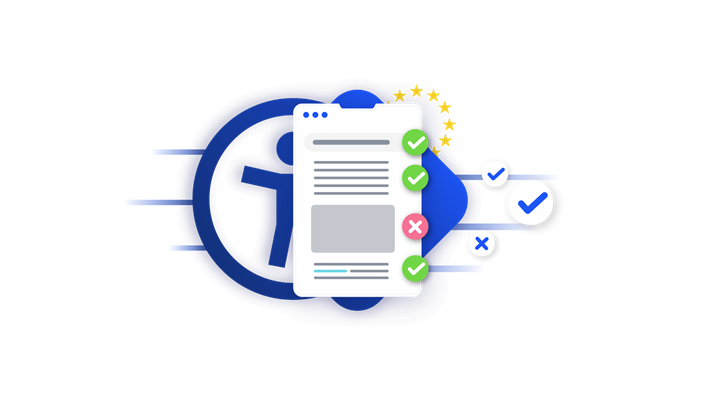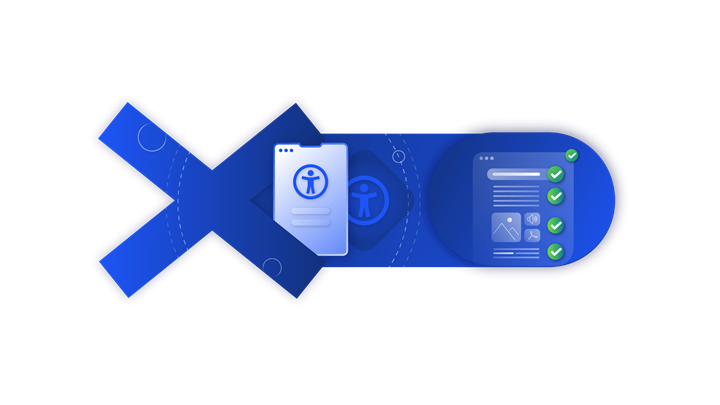Overview of website accessibility laws
All organizations, whether in the public or private sector, need to prepare to make their websites and mobile apps accessible, if they want to remain competitive and compliant. Although web accessibility is developing around the world, this article will cover the must-know accessibility laws and regulations in the US, EU, Canada, and Australia.
Over a billion people world-wide live with some form of disability and that number is expected to grow due to an increase in chronic health conditions and aging population. Awareness of disability rights has gained traction and with it an increase in accessibility laws and regulations, as well as lawsuits.
Why are there website accessibility laws?
Digital technology has made life more convenient with online shopping, e-banking, food delivery apps, and even online healthcare services. Unfortunately, access to these technologies is not always inclusive to people with disabilities.
To prevent this discrimination and strive towards more equal access, countries around the world are publishing laws about web accessibility. As accessibility laws struggle to catch up with technological developments, however, there has been much confusion over what these laws entail, who they apply to, and what organizations should do to comply and avoid litigation. Let’s go over the accessibility laws and regulations you need to know about if you live in the US, EU, Canada, or Australia.

US website accessibility laws
The Rehabilitation Act of 1973 was the first time in US history that the law prohibited the discrimination of people with disabilities. Before this, people with disabilities did not have equal access to public transportation, telephones, bathrooms, and buildings. Now that daily life is carried out via digital platforms, accessibility laws
Section 508
Section 508 is an amendment from 1998 that was added to the Rehabilitation Act of 1973. It requires Federal agencies to ensure their electronic and information technology is equally accessible to people with disabilities.
In 2018, Section 508 was officially updated to include new requirements that reflect technological developments. It also now includes the Web Content Accessibility Guidelines (WCAG), an international standard for accessibility. By doing so, Section 508 has harmonized accessibility requirements with other nations’ accessibility laws, as WCAG is recognized across the world as a comprehensive standard. A thing to note is that Section 508 does not apply to private organization’s websites unless the organization receives federal funds or is employed under contract with a federal agency.
ADA
The Americans with Disabilities Act (ADA) is a law enacted in 1990 to ensure people with disabilities are not discriminated against. Title I of the ADA covers discrimination in the workplace while Title II applies to State and local government entities. Title III of the ADA ensures that places of public accommodations and commercial facilities, such as restaurants, movie theaters, and doctors’ offices, are accessible. Although web accessibility is not explicitly stated, if a business offers products and services on their website or mobile apps, they must still ensure that people with disabilities have equal access.
EU website accessibility laws
The EU has taken big steps towards establishing harmonized accessibility standards for EU member states, first with the EU Web Accessibility Directive and then the European Accessibility Act (EAA). Both of these directives are not laws in and of themselves, but rather, the directives outline what accessibility should look like, and then it is up to each EU member state to integrate the directive into national laws. The former focuses on the public sector, while the latter applies to private companies
EU Web Accessibility Directive
The EU Web Accessibility Directive states that public sector bodies must ensure their websites and mobile apps abide by the WCAG 2.1 Level AA accessibility standard. By public sector bodies, it means state, regional, and local authorities, as well as bodies governed by public law.
The only exempt organizations are public service broadcasters, most schools, and non-governmental organizations (NGOs) that do not provide services essential to the public or for people with disabilities. As of June 23, 2021, all relevant public organizations must ensure all their websites and mobile apps are accessible.
European Accessibility Act
The EAA, formally known as Directive 2019/882, is an EU directive that aims to create a common accessibility standard for essential products and services traded between EU member states. It applies to manufacturers or producers of computers and operating systems, ATMs, ticketing machines, banking services, ecommerce website and apps, to name a few. The EAA was adopted by the EU in June 2019 and will need to be transposed into national law by member states by June 2022 and be fully applied by June 2025.
Canadian website accessibility laws
Canada boasts several federal and provincial accessibility laws and legislation, which indicates their commitment to a more inclusive, barrier-free society. Because there are multiple accessibility laws in Canada, it can be confusing to know which impact you and your organization. Here is a brief overview of all the laws that might apply to you depending on where in Canada you reside.

The Accessible Canada Act
The Accessible Canada Act, or Bill C-81, became law on June 21, 2019. The Act is part of a mandate for a barrier-free Canada and seeks to prevent accessibility barriers in Information and Communications Technologies (ICT). It is a requirement for any organizations under federal jurisdiction. Those who fail to comply risk a fine of up to $250,000.
Accessibility for Ontarians with Disabilities Act
The Accessibility for Ontarians with Disabilities Act (AODA) became law in 2005 with the goal to create a barrier-free Ontario by 2025. As of January 1, 2021, the AODA requires public, private, and non-profit organizations to ensure their websites and web content comply with WCAG 2.0 Level AA. Organizations that do not comply risk fines of up to $100,000 for each day of violation.
Accessibility for Manitobans Act
The Accessibility for Manitobans Act (AMA) was passed into law in 2013 as part of Manitoba’s goal to become more inclusive by 2023. The AMA consists of five accessibility standards that cover key areas of daily life. The standard that relates to web accessibility is the Information and Communications accessibility standard and while it is still under development, you can expect the standard to follow the WCAG standard. Once the standard comes into force, the timeline will be phased in over four years with different timelines for three groups: the Manitoba government, public sector (excluding small municipalities), and all other organizations (including private businesses).
Nova Scotia Accessibility Act
Nova Scotia is the third province, following Ontario and Manitoba, to pass accessibility legislation with the Nova Scotia Accessibility Act, also known as Bill 59, which became law in 2017. There are six standards currently under development that will cover accessibility across different areas of daily life, similar to what the AMA is undergoing. The standard related to web accessibility is also known as the Information and Communications standard and can be expected to follow the WCAG 2.0 Level AA accessibility requirements.
British Columbia Accessibility Act
The British Columbia Accessibility Act, or Bill 6, was proposed in 2021 and if passed, could be in effect by the end of 2022 with the overall goal of creating an accessible British Columbia by 2024. This legislation will establish accessibility standards and regulations that remove barriers across different areas, similar to the AMA and Nova Scotia Accessibility Act, including information and communication.
Australian website accessibility laws
The 1980s were a turning point for disability rights in Australia as awareness and advocacy for disability rights continued to grow. The Disability Services Act 1986 was significant in providing a framework for funding and provision of disability support services, which gave disability rights recognition as an essential area to improve upon. Since then, there have been further developments to protect the rights of people with disabilities that both public and private sector organizations must be aware of.
Disability Discrimination Act
Australia’s Disability Discrimination Act 1992 applies to both the private and public sectors and explicitly prohibits providers of goods, services, and facilities from discriminating against people on the ground of a disability. This extends to websites and other digital resources, including financial services, education, employment, public transport services, etc. Refusal to make a reasonable adjustment to your website for users with disabilities is considered discrimination and could leave you open to legal action.
Accessibility requirements for ICT products and services
The Accessibility requirements for ICT products and services, formally known as AS EN 301 549:2020, was revised and adopted in 2020. It now ensures that ICT products and services procured by government agencies in Australia comply with the WCAG 2.1 Level AA standard, whereas the previous version of the standard (AS EN 301 549) only required WCAG 2.0 Level AA. By products and services, the standard covers hardware and software, video technology, websites, digital documents, and technologies that provide access to emergency services.
The risks of not having an accessible website
The exact repercussions for failing to maintain an accessible website vary from country to country, since the laws are not all the same. However, with more laws protecting the rights of people with disabilities, also comes greater chances of having legal action brought against your organization if your websites and mobile apps are not accessible. In the US alone, there was a 23% increase in ADA-related lawsuits in the year 2020. Accessibility lawsuits brought against big names, such as Netflix in 2011, Harvard and MIT in 2015, Domino’s in 2016, and Parkwood Entertainment’s Beyonce.com in 2019, have brought significant attention to web accessibility. With growing awareness and legislation, paired with more industries undergoing a digital transformation, you can expect the trend for increased legal and brand backlash to continue. Get ahead by preparing for accessibility now.
